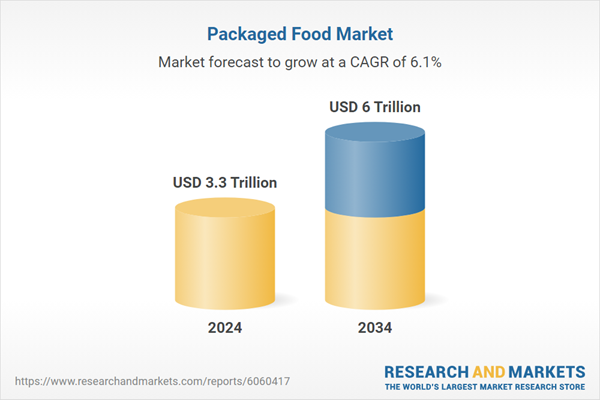The Packaged Food Market was valued at USD 3.3 trillion in 2024, and is projected to reach USD 6 trillion by 2034, rising at a CAGR of 6.1%. Growth drivers include the increasing popularity of organized food retail, the surge in e-commerce, and the rising preference for convenience foods. The pandemic accelerated e-commerce spending and the demand for packaged foods, especially in regions like North America, Europe, and parts of Asia Pacific. The growing middle class and an increase in disposable income, particularly in developing nations, are expected to fuel demand for packaged foods. As consumers lean toward healthier options such as organic, plant-based, and fortified foods, the packaged food sector is evolving to meet these preferences. The shift toward sustainability, driven by eco-conscious consumers, is also influencing packaging and product development, encouraging brands to use biodegradable materials and improve shelf life.
Despite these positive growth factors, the industry faces challenges. Supply chain complexities, rising raw material costs, and stringent government regulations are creating hurdles. There is also increasing competition between private label brands and local players, intensifying market pressure. However, adopting aggressive marketing strategies, investing in product innovation, and leveraging digital platforms could help businesses stay competitive. The bakery and confectionery segment has led the market, accounting for over 21% of the total revenue in 2024, driven by consumer demand for baked goods, snacks, and healthier alternatives like low-sugar and gluten-free options. The use of cans and tins for packaging remains dominant, as they are cost-effective, easy to store, and recyclable.
The packaged food market is increasingly shifting to e-commerce, which is expected to experience the fastest growth at a CAGR of 6.8% over the next decade. This growth is due to the convenience of online shopping and the expanding variety of products available. However, offline retail channels continue to hold strong, particularly in urban and suburban areas where organized retail chains and supermarkets are thriving.
The U.S. market alone is expected to surpass USD 707.4 billion by 2034, fueled by consumer demand for clean-label products, organic foods, and sustainable packaging. The push toward reducing food waste and improving sustainability is also pushing the industry to adapt, with more companies focusing on recyclable and compostable materials.
This product will be delivered within 2-4 business days.
Despite these positive growth factors, the industry faces challenges. Supply chain complexities, rising raw material costs, and stringent government regulations are creating hurdles. There is also increasing competition between private label brands and local players, intensifying market pressure. However, adopting aggressive marketing strategies, investing in product innovation, and leveraging digital platforms could help businesses stay competitive. The bakery and confectionery segment has led the market, accounting for over 21% of the total revenue in 2024, driven by consumer demand for baked goods, snacks, and healthier alternatives like low-sugar and gluten-free options. The use of cans and tins for packaging remains dominant, as they are cost-effective, easy to store, and recyclable.
The packaged food market is increasingly shifting to e-commerce, which is expected to experience the fastest growth at a CAGR of 6.8% over the next decade. This growth is due to the convenience of online shopping and the expanding variety of products available. However, offline retail channels continue to hold strong, particularly in urban and suburban areas where organized retail chains and supermarkets are thriving.
The U.S. market alone is expected to surpass USD 707.4 billion by 2034, fueled by consumer demand for clean-label products, organic foods, and sustainable packaging. The push toward reducing food waste and improving sustainability is also pushing the industry to adapt, with more companies focusing on recyclable and compostable materials.
Comprehensive Market Analysis and Forecast
- Industry trends, key growth drivers, challenges, future opportunities, and regulatory landscape
- Competitive landscape with Porter’s Five Forces and PESTEL analysis
- Market size, segmentation, and regional forecasts
- In-depth company profiles, business strategies, financial insights, and SWOT analysis
This product will be delivered within 2-4 business days.
Table of Contents
Chapter 1 Methodology & Scope
Chapter 2 Executive Summary
Chapter 3 Industry Insights
Chapter 4 Competitive Landscape, 2024
Chapter 5 Market Estimates and Forecast, by Product Type, 2021-2034 ($ Bn) (Kilo Tons)
Chapter 6 Market Estimates and Forecast, by Packaging, 2021-2034 ($ Bn) (Kilo Tons)
Chapter 7 Market Estimates and Forecast, by Distribution Channel, 2021-2034 ($ Bn) (Kilo Tons)
Chapter 8 Market Estimates and Forecast, by Region, 2021-2034 ($ Bn) (Kilo Tons)
Chapter 9 Company Profiles
Companies Mentioned
The companies featured in this Packaged Food market report include:- Associated British Foods plc
- Conagra Brands Inc.
- Danone S.A.
- Foshan Haitian Flavouring and Food Company Ltd
- General Mills Inc.
- Hormel Foods Corporation
- JBS S.A.
- Kellogg Company
- Mars
- Incorporated
- Mondelez International Inc.
- Nestlé S.A.
- PepsiCo Inc.
- The Kraft Heinz Company
- Tyson Foods Inc.
- Unilever
Table Information
| Report Attribute | Details |
|---|---|
| No. of Pages | 360 |
| Published | February 2025 |
| Forecast Period | 2024 - 2034 |
| Estimated Market Value ( USD | $ 3.3 Trillion |
| Forecasted Market Value ( USD | $ 6 Trillion |
| Compound Annual Growth Rate | 6.1% |
| Regions Covered | Global |
| No. of Companies Mentioned | 17 |









